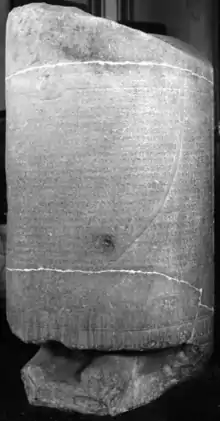Panamuwa II inscription
The ‘’’Panamuwa II inscription’’’ is a 9th-century BC stele of King Panamuwa II, from the Kingdom of Ya'diya in Sam'al. It is currently occupies a prominent position in the Vorderasiatisches Museum Berlin.[1]
_stretched.jpg.webp)
The inscription, in stretched form
.jpg.webp)
The Panamuwa II inscription

Panamuwa II inscription
The 23 inscription was discovered in 1888 during the 1888-1902 German Oriental Society expeditions led by Felix von Luschan and Robert Koldewey.
Similar to the Hadad Statue, the inscription is on the base of a pillar-shaped statue. It was written by Panamuwa II's son Bar Rakib in the Samalian language, considered to be on a dialect continuum between Phoenician and Aramaic. The inscription mentions Tiglath-Pileser III.
References
- Craig, J.A., "The Panammu Inscription of the Zinjirli Collection" The Academy 43 (1893): 351–52, 441
Bibliography
- Halévy, J., "Procès-verbal de la séance générale du 26 juin 1891." JA ser. 8, vol. 18 (1891): 5–9.
- Sachau, E., "Zur historischen Geographie von Nordsyrien." SPAW 21 (1892): 313–38
- Belger, C., "Sendschirli II." Berliner philologische Wochenschrift 13 (1893): 355–56, 385-88
- Derenbourg, H., "Pînamou, fils de Karîl." REJ 26 (1893): 135–38
- Halévy, J., "Deux inscriptions sémitiques de Zindjîrlî." RevSém 1 (1893): 77–90
- Luschan, F. von, "Fünf Bildwerke aus Gerdschin." Pp. In Ausgrabungen in Sendschirli, I. , Berlin: W. Spemann, 1893
- Müller, D.H., "Die altsemitischen Inschriften von Sendschirli." WZKM 7 (1893): 33–70, 113-40
- Šanda, A., "Zur Panammu-Inschrift Zeile 16." BZ 2 (1904): 369. Pan
This article is issued from Wikipedia. The text is licensed under Creative Commons - Attribution - Sharealike. Additional terms may apply for the media files.